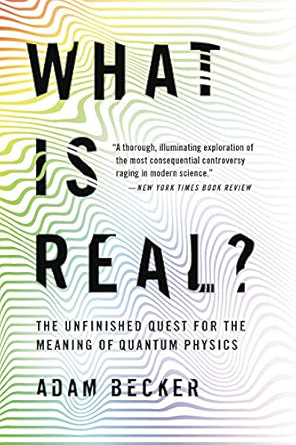More on this book
Community
Kindle Notes & Highlights
by
Adam Becker
Read between
March 26 - March 30, 2018
Like most epic heroes, atoms have some problems that ordinary humans don’t. We are creatures of habit, monotonously persisting in just one location at a time. But atoms are prone to whimsy. A single atom, wandering down a path in a laboratory, encounters a fork where it can go left or right. Rather than choosing one way forward, as you or I would have to do, the atom suffers a crisis of indecision over where to be and where not to be. Ultimately, our nanometer Hamlet chooses both. The atom doesn’t split, it doesn’t take one path and then the other—it travels down both paths, simultaneously,
...more
“Mach’s epistemology… appears to me to be essentially untenable,” Einstein wrote. “It cannot give birth to anything living. It can only exterminate harmful vermin.”
Pauli’s scathing put-downs were legendary, earning him the nickname “the Wrath of God.” “I do not mind if you think slowly, but I do object when you publish more quickly than you can think,” he once told a colleague.
The response to Einstein’s thought experiment from the rest of the conference was muted incomprehension. Bohr, to his credit, admitted as much. “I feel myself in a very difficult position because I don’t understand what precisely is the point which Einstein wants to [make],” he said. “No doubt it is my fault.” Einstein’s simple thought experiment offered a devastating critique of the Copenhagen position, but its simplicity may have paradoxically been a barrier to understanding: Einstein’s presentation of it was quite brief and may have given the impression that he was confused about the nature
...more
The average English family certainly didn’t have Farm Hall’s full complement of hidden microphones in each room. “I wonder whether there are microphones installed here?” asked Kurt Diebner, one of the German physicists, several days after their arrival. “Microphones installed?” replied Heisenberg, laughing. “Oh no, they’re not as cute as all that. I don’t think they know the real Gestapo methods; they’re a bit old fashioned in that respect.”
Pascual Jordan maintained that he had never truly supported the Nazi cause, despite his publications extolling the virtues of a National Socialist approach to science. He even had the audacity to send a letter to Max Born, his mentor who had been forced out by Hitler’s racist policies, explaining that he hadn’t really been a Nazi and asking for a character reference for his “de-Nazification.” Born replied with a list of his friends and family members murdered by the Nazis.)
The Copenhagen interpretation, true to form, gives a mystical pseudo-answer steeped in the language of Bohr’s philosophy of complementarity. The idea of particles, Copenhagen claims, is complementary to the idea of waves. The ideas are contradictory—photons cannot be both particles and waves—but both are necessary, in alternation, for describing this experiment.
Rosenfeld’s twinned devotions to complementarity and Marxism led Pauli to nickname him “square root of Bohr × Trotsky.”
At twelve, he wrote a letter to Einstein, claiming to have solved the question of what would happen if an immovable object met an unstoppable force. The letter is lost, but Einstein replied, saying that while unstoppable forces and immovable objects weren’t real, “there seems to be a very stubborn boy who has forced his way victoriously through strange difficulties created by himself for this purpose.”
solipsism—the idea that you are the only being in the universe, and everyone else is somehow illusory or secondary, existing in states of indeterminate reality until you, the High Arbiter of Wave Function Collapse, deign to observe them. In his thesis, Everett admitted that this is an internally consistent view, but that “one must feel uneasy when, for example, writing textbooks on quantum mechanics, describing [wave function collapse], for the consumption of other persons to whom it does not apply.”
It’s difficult for ordinary computers to factor large numbers—and, as Shor well knew, this difficulty was the basis for nearly all forms of practical cryptography, especially for secure communications over the newly burgeoning Internet. Shor had demonstrated that any kind of secure financial transaction over a computer network—from buying books to trading stocks—would be impossible to accomplish by conventional means in a world with working quantum computers. But, by that time, quantum information theory had also yielded a solution to this problem: quantum cryptography.
I'm not quite sure about this.My sense is that considerable amounts of modern crypto would survive in a post-quantum world: In particular, Kerberos would still be secure. Contra-wise, quantum crypto doesn't do authentication which is the important bit that public-key crypto gets you.
Quantum physics works. The calculations enabled by the theory are astonishing in their range of applicability and the accuracy of their results. Quantum physics tells us how long it will take to heat up your frying pan to cook your eggs and how large a dying white dwarf star can be without collapsing. It reveals the exact shape of the double helix at the core of life, it tells us the age of the immortal cattle on the rock walls at Lascaux, it speaks of atoms split beneath the stone heart of Africa eons before Oppenheimer and the blinding light of Trinity. It predicts with uncanny accuracy the
...more


